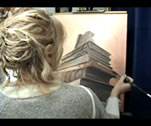This section provides a list of techniques, materials, and common references that are frequently used in the design and decorative painting profession.
The term refers to a shiny and deep finish that is thick and durable, and wraps the treated object with a flawless coating. Lacquer is obtained with a tree-produced gummy substance that is diluted and tinted. It is mostly in Asia, Japan, China, Viet Nam and Korea that artisans produce small lacquered objects and furniture, generally in black, brown, burgundy and red. One could compare the high quality of lacquer to the French "vernis Martin" in terms of perfection of the execution and finish.
The beauty of the lacquer comes not from the gloss, which is not particularly high, but from the unequaled smoothness of the finish and the decor on top of it. On a piece of furniture or an object, a feasible and rewarding method to imitate this effect is to spread a diluted coat of oil paint from the brand "Fine paints of Europe" on a well-prepared, flat, waterproof, and flawless surface. It is an oil-based paint that stretches and leaves a brilliance that no American paint shares. You will need to apply several coats with a very fine sanding in-between, and you must dilute the paint that would otherwise be too thick to spread. It will not need to be sealed with a finish, except if you create a design on the outer coat that you wish to seal. In this case, you will have been well advised to use a spray finish. On walls, varnish on top of glaze or tinted varnish will give you a high glossy surface; the quality of the result will be tied to the surface preparation andthe malleability of the varnish. Remember that many oil-based varnishes yellow and are often thick, hence hard to apply. Water-borne varnishes are runny and tend to deliver an uneven final gloss. Sampling the future work will give you a better idea of what type of lacquer to use, the dilution needed, and the quality of the gloss. In a small room, such as a powder room, defects may be less visible; otherwise, natural or electric light will magnify every wall or surface imperfection.
It is environmentally friendly, easy to clean, and dries quickly. The modern latex paints are of better quality and aremore resilient. Latex paint can be used as a base-coat before glazing walls. Diluting latex paint with water or Floetrol or an acrylic glaze will give more transparence to the color and a less grainy finish. For more durability, you may apply an acrylic finish to seal it.
This quarried stone offers a sense of privilege to entrances or foyer walls because it brings with it the classicism of the centuries where it was in use as a bare wall decor. Limestone, Caen stone, travertine or tuffeau have been selected indifferently for this purpose. Trompe l'oeil of these stones are very popular; they display colors ranging from champagne to dark grey beige, with a mortar line visible between the blocks in white, grey or brown, accompanied by a shadow line. The stone decor creates a strict and elegant decor that needs minimum accessories and furniture to enliven it. It is remarkably easy to simulate, although time consuming.






